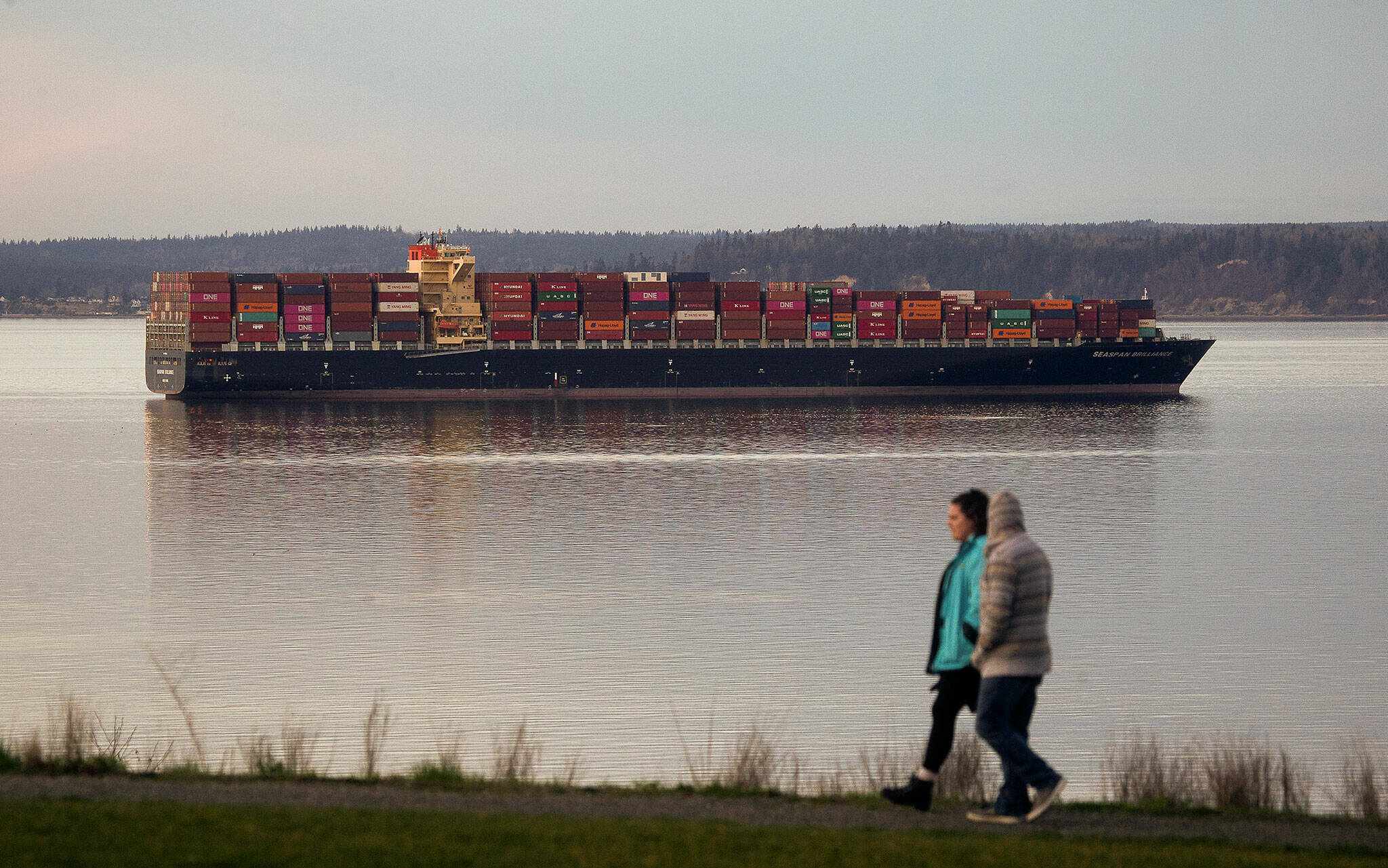EVERETT — You ordered a new couch three months ago — now where is it?
Is it still aboard a cargo ship waiting to secure a berth? Has it even been built?
Lisa Lefeber, CEO of the Port of Everett, might be able to explain why it hasn’t been delivered.
You can start with supply chain disruptions — the gridlock of goods, vessels, seaports and ground transportation brought on by the COVID-19 pandemic; temporary factory shutdowns in China, which manufactures one-third of the world’s consumer goods; and the sea-going cargo industry’s growing reliance on larger ships.
Normally, the supply chain is an efficient, well-oiled machine, said Lefeber, who offered a primer during a recent virtual discussion sponsored by Economic Alliance Snohomish County.
Lefeber was joined by Carl Wollebek, the Port of Everett’s chief operating officer.
You place an order for furniture, clothing or food and it arrives at your door in timely fashion and “everybody’s happy,” Lefeber said.
These days, the course isn’t so smooth.
COVID-19 snarled the global supply chain, but other factors are, and were, at play, Lefeber said.
For starters, it helps to know that 90% of the worlds’ goods — imports and exports — are transported by ship. The remainder travel by air, usually as belly cargo on passenger planes or in an air freighter, Lefeber said.
Even before the pandemic, the international shipping industry had begun to change course.
With the goal of putting “more containers on fewer ships,” major maritime companies began adding larger vessels to their fleets.
It was a dramatic shift that “happened almost overnight,” Lefeber said.
The problem was only a handful of ports could accommodate the super-sized ships, which require larger, sturdier container terminals to off-load, she said. (In recent years, many seaports, the Port of Everett included, have sought to upgrade their facilities to serve larger vessels.)
Then the pandemic struck, and the dearth of big-ship accommodations became an even more pressing problem.
As the number of coronavirus infections rose, workforce shortages ensued. With deckhands and dock workers sick or quarantined, there were fewer people to load and unload the ships.
But there was another disruptive force affecting the industry — a change in consumers’ buying habits, Lefeber said.
Businesses and consumers went on a buying spree, she said.
“It’s was easy for people to buy on their phones,” Lefeber said of the surge in consumer purchases that marked 2020 and 2021.
With the pandemic keeping people indoors or working from home, along with low interest rates, home improvement and redecorating projects took off.
Standard-term mortgages, refinances and cash-out loans, which can be used for home improvement, were at all-time lows.
As a result, demand for lumber, furniture, appliances and building and construction supplies skyrocketed.
Businesses also changed their buying habits. The supply chain’s standard just-in-time model, which allows companies to keep inventory on hand to a minimum, also contributed to shortages as supplies were slow to arrive.
When retailers and grocery stores saw shoppers empty the shelves of toilet paper and cleaning supplies, for example, “everyone started getting nervous,” said Wollebek, the port’s chief operating officer.
Instead of slowing down purchases, which could have helped relieve pressure on the supply chain, businesses revved up buying, Wollebek said.
Companies adopted a “just-in-case” model that emphasized having plenty of stock on hand. “Nobody wanted to get caught empty-handed,” Wollebek said.
So with a limited number of seaports able to handle the largest cargo ships, a depleted workforce, full warehouses and a shortage of shipping containers, there was a perfect storm, said Lefeber — an upended supply chain.
“The end result is you started seeing ships stacking up around harbors throughout the United States, particularly on the West Coast,” Lefeber said.
Now there are new worries over production slowdowns at factories in China, Wollebek said.
In some cities and regions, manufacturers which normally operate seven days a week are open three or four days a week, Lefeber said.
It’s another reason people might still be waiting on furniture or appliances, or industrial equipment needed to support housing or restaurant construction, Lefeber said.
China’s zero-tolerance policy to contain COVID-19 has immobilized entire cities for days and weeks.
When authorities in Tianjin, which has a population of 14 million, recently discovered that a few residents were infected with the omicron coronavirus variant, they placed the city on a partial lockdown.
That response has only tightened as the Winter Olympic Games approach.
“It’s not uncommon for them — if they get a few cases of COVID to shut down an entire port for a few days,” Wollebek said of China.
When will the supply chain snarl untangle and unwind?
“Nobody knows how long this is going to last,” Lefeber said. “Don’t buy furniture right now if you can avoid it.”
Janice Podsada; jpodsada@heraldnet.com; 425-339-3097; Twitter: @JanicePods.
Talk to us
> Give us your news tips.
> Send us a letter to the editor.
> More Herald contact information.

























